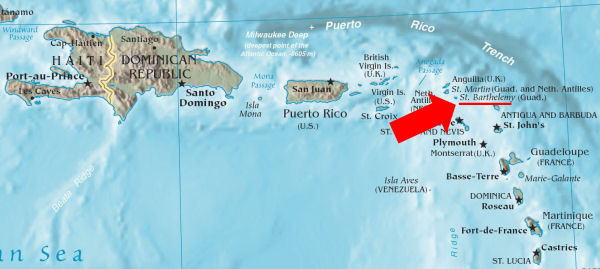Where is Saint Barth

General information about Saint Barth
Saint Barthélemy (French: Saint-Barthélemy), officially the Territorial collectivity of Saint Barthélemy (French: Collectivité territoriale de Saint-Barthélemy), is an overseas collectivity of France. Often abbreviated to Saint-Barth in French, or St. Barts in English, the indigenous people called the island Ouanalao. The collectivity is one of four territories among the Leeward Islands in the northeastern Caribbean that comprise the French West Indies, along with Guadeloupe (125 miles (201 km) southeast), Martinique and Saint Martin. St. Barts lies 20 miles (32 km) southeast of Sint Maarten/Saint Martin, and north of St Kitts. Puerto Rico is 150 miles (240 km) to its west in the Lesser Antilles.
St. Barts, a volcanic island fully encircled by shallow-water reefs, has an area of 8 square miles (21 km2) and a population of 8,823 (census 2008). Its capital is Gustavia, which also contains the main harbour to the island. It is the only Caribbean island which was a Swedish colony for any significant length of time; Guadeloupe was under Swedish rule only briefly, at the end of the Napoleonic Wars. Symbolism from the Swedish national arms, the Three Crowns, still appears in the island’s coat of arms. The language, cuisine and culture, however, are distinctly French. The island is a popular tourist destination during the winter holiday season. […]
Small villages are seen spread out in the rolling hills in the interior. Gustavia, the capital of the island is located in a natural harbour which has witnessed many historical transitions. Yachts are a common sight in the harbour. The oldest settlement still remaining is the village of Lorient (or L’Orient). […]
According to the 2008 census, St. Barts had 8,823 inhabitants. […]
Many of the full-time residents are French citizens who work at the various establishments on the island. Most of the population are French-speaking descendants of the first settlers, Breton, Normand, Poitevin, Saintonge and Angevin lineage. The widely spoken language is Norman dialect, French and English are also spoken by people of the island. However, French is the primary language spoken, in standard form as well as the native dialects, Saint-Barthélemy French patois and Antillean Creole. English is increasingly the language of hotels and restaurants, although a small population of Anglophones has been resident in Gustavia for many years. The St. Barts French patois is spoken by some 500–700 people in the leeward portion of the island and is superficially related to Quebec French, whereas Creole French is limited to the windward side. Unlike other populations in the Caribbean, language preference between the Creole and Patois is geographically determined, and not racially.
Tourism in Saint Barth
International investment and the wealth generated by wealthy tourists explain the high standard of living on the island. St. Barts is considered a playground of the rich and famous, especially as a winter haven, and is known for its beaches, gourmet dining and high-end designers. The food, energy and water shortages in the island are supplemented by food imports, energy sources and desalination plants. Tourism attracts about 200,000 visitors every year. As a result, there is a boom in house building activity catering to the tourists and also to the permanent residents of the island. St. Barts has about 25 hotels, most of them with 15 rooms or fewer. The largest has 58 rooms. Hotels are classified in the traditional French manner; 3 Star, 4 Star and 4 Star Luxe. Most of places of accomodation are in the form of private villas, of which they are some 400 available to rent on the island. The island’s tourism industry, though expensive, attracts 70,000 visitors every year to its luxury hotels and villas and another 130,000 people arrive by luxury boats.
Atmosphere in Saint Barth
Very safe, I felt as in some small towns in Switzerland. The children are always welcome, also in the restaurants. The service level and customer orientation (restaurants, hotels, shops, etc.) is quite high. There aren’t a lot of people on the island and on the beaches, although we stayed in St.Barths during the high season. Local people are friendly and cool, also on the streets with their cars. The beaches are very clean. See the funny ashes they are using. Some tourists felt some kind of snobbish atmosphere. I don’t agree at all: all the people are dressed *very* informal and casual, sometimes that was really too much, specially in some very good restaurants :-) I didn’t see one tie during our whole stay. The local people and the tourists are really cool.
Getting to Saint Barth
The principal gateway to St. Barts (SBH) is through Juliana Airport in nearby Dutch St Maarten, where flights arrive daily from both the USA and Europe.
USAIR, Delta, Continental, American Airlines, and United Airlines have direct flight to St Maarten Juliana (SXM) from the USA: Philadelphia, PA; Charlotte, NC; Atlanta, GA; Miami, FL; San Juan, PR; New York and Newark.
Air France, Corsair , Alitalia, and KLM have regular flights to St Maarten and Guadeloupe from Europe.
From St Maarten, Winair, Air Caraïbes, and St Barth Commuter, make the ten minute shuttle flights to St Barts (SBH).
From Guadeloupe, Air Caraïbes offers a few direct flights to St Barts (45 minutes) and others via St Marteen departing at times meant to accommodate the arrival of the bigger planes from Europe.
Air Caraïbes also has sereral flights a week between San Juan and St Barts via St Marteen.
Locally based charter flights, which can ease transfer, especially from San Juan and Antigua, are also available.
The airstrip in St Barts is small, and pilots are required to have special training to land. For many, the landing, especially on a windy day, is an adventure in itself.

